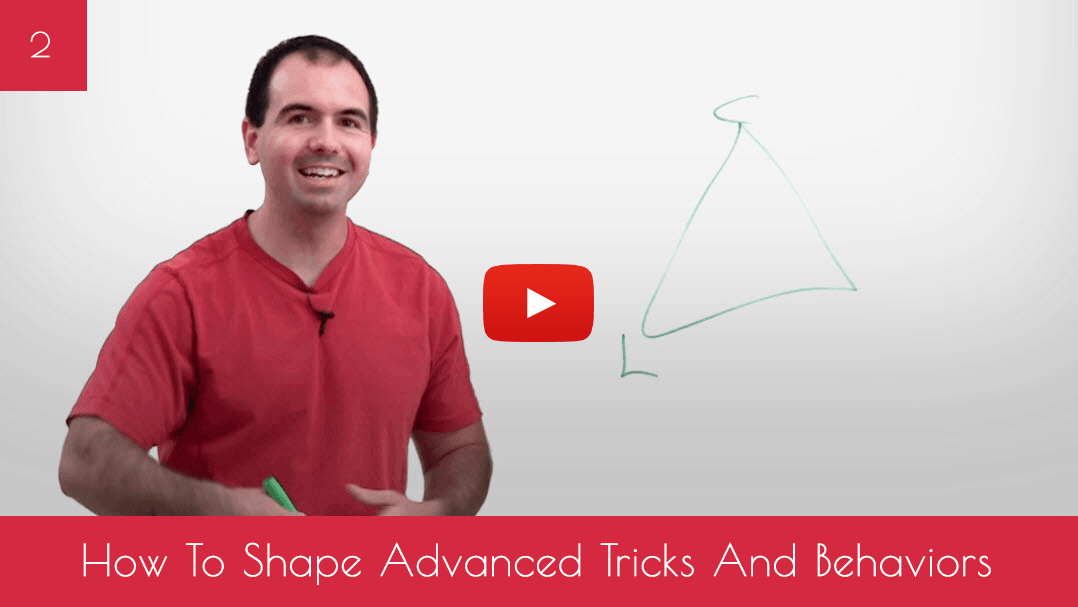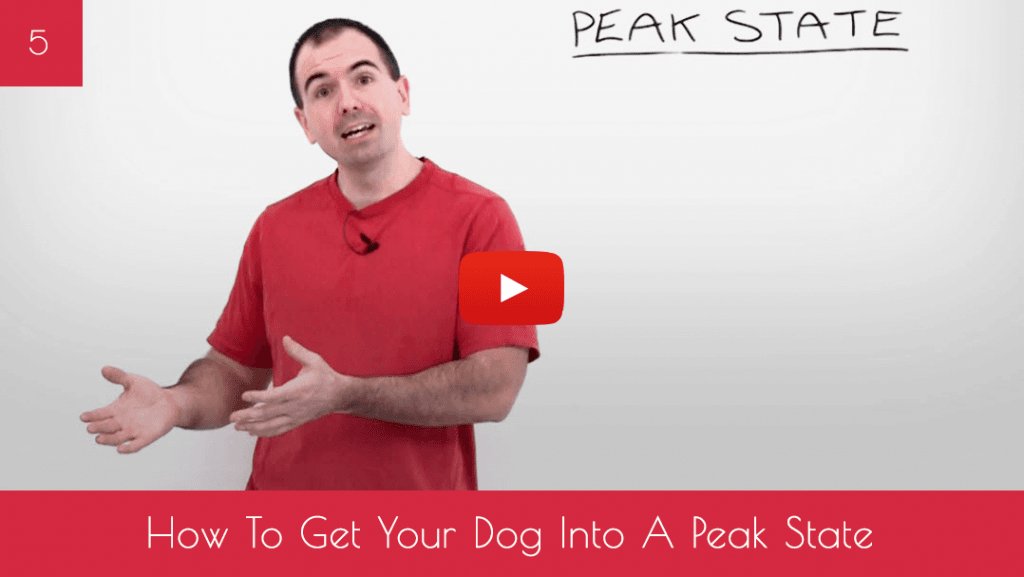Where would you like me to send your FREE 5-part video series?
Almost there!
Please complete the form below and we'll send it to your inbox.
We respect your privacy!
You may unsubscribe from our mailing list at ANY time.





Excellent, easy to understand!
It is often more difficult to train the owners then the dogs – the videos get it across very nicely!
Marina
Paws for People Therapy Dog Unit Vaal, South Africa
Thank you! 🙂
Great video, great dog, great training. Do you have steps by steps video of training dogs for tricks, where i can see how is the learning in non educated dogs?
I am amaze how your dog gets by you at the “get in” command.
Thank you. Yes I plan on making more videos in the next few weeks and some of them will be of dog tricks. Her “Get In” behavior is so strong because I’ve built in so much value in being in that position. She’s been rewarded hundreds of times for doing that behavior so it’s really second nature to her now.
I have a question. You are always standing when you talk to your dog. I have 2 tiny dogs. Is it good for me to be towering over them or should I be down at there level?
Kimberly
Ideally, you would want to get your dog to obey all of your commands while standing. You don’t want to be in a position where you dog only listen when you are kneeling down or towering over them. But this can be tricky if you are using food lures to train your dog. If this is the case, you might want to train the behavior kneeling, then switching to a hand signal and gradually stand. Of course you could also use shaping which you can simply throw treats from a standing position. 🙂
Great video, as always! I will be sharing on Twitter. Well done, Jean. 🙂
Thank you for sharing and spreading the word about PRT (Positive Reinforcement Training!)
Love the building up of the three ways to get the dog to understand the verbal command conditioning. Very simple but very effective.
This is so simple and so effective, just shows how quick my 6 month Cockapoo gets things right with this method.. Thanks Jean love it!!
Awesome! Glad to hear that you are training your puppy early on. 🙂
Great videos. Thanks.
Thank you for making these informative videos. We have a corgi/terrier rescue mix who is 18 mos. I am training her to “come” with treat reinforcement but I have been using her name and then the “come” – will try just command. Your dog, Onyx, is beautiful!
You are most welcome! 🙂
I am impressed with your videos, and the clarity of your instructions. these are excellent videos to share with clients. So far I have agreed with your techniques of training, and of course your philosophy of training with positive reinforcement. Thank you!
You are quite welcome! Thank you for taking the time to watch them. 🙂
Very true and practical.
Do you always just say “yes” before you reward/reinforce a behavior, or do you also use clicker training? Your video is nice and easy for people to understand, but in my opinion a clicker is more precise and consistent than a voice.
Thank you for your comment Nini.
It always depends on the situation and the complexity of the behavior. Sometimes I will use a verbal marker (Yes!) and other times I will use a clicker. There are even times when I don’t use a marker at all when I can deliver the reinforcement quickly enough.
The only time that I will use a clicker is when shaping or training a complex behavior that requires precise timing.
But you are welcome to use a clicker if you want, I think it’s a great tool and it will definitely work with your dog!
Did not explain why not to use the dogs name before the verbal command. I do it to get there attention if there are distractions with training.
Please let me know the reasoning behind “no name”.
Hi Lynn, you can always use your dog’s name for attention, that is not a problem. The issue is when it becomes a habit, when you always say the dog’s name before giving a command.
For example, I’ve seen people do this: “Fido, Come!”, “Fido, Sit!”, “Fido, Stand!”. This makes it harder for the dog to discriminate between commands plus the first part (his name) becomes irrelevant.
Hi Your video is nice and easy for people to understand. I just wonder if you ever use a clicker, or do you always just use your voice with the “yes”? In my opinion a clicker is more consistent and precise..
never mind…I did not see your answer above 😛
Thank you for everything, it was very informative and i am looking forward to using these techniques on my dog alfie 🙂 you make it so easy to understand, i love your dog onyx shes beautiful, i’m looking forward to watching the other videos many thanks again jean 🙂
You are very welcome Rosie! 🙂
Again, a really informative, uncomplicated, friendly and delightful video. Thank you.
My Jack Russell is 10yo, highly strung and has a short attention span.
I have never taught him ‘tricks’ but he is obedient in all respects bar one.
We allowed him to follow his natural instinct to chase cats when they came into our yard to kill our chickens. Now that we no longer have chickens, do you think it would be possible to positively UN-reinforce this behaviour? I sometimes think he could jump off a cliff chasing a cat. It is very difficult to get his attention off a cat if he knows there is one around and he loses all interest in treats.
Actually, just writing that down makes me realize the answer has to be ‘No’. 🙁
Do you have a video showing how to teach the “Get In”? There must be many steps and it would be helpful to see how to start and progress.
Enjoyed the videos I have seen Thanks.
I do have a lesson that teaches this behavior inside my “Good Dog Every Day Program” that is sold on my other website, Success Dogs. You can get it here: https://www.successdogs.com/online-dog-training-courses/
Hi, I love these videos, I would like to see one in how you get your dog to “get In”… How do you get your dog to do that. I try this with “Heel” command. but my husky only comes with food or if I put her there.
Hi Luann,
The reason that my dog is so good at getting to my side is because I’ve reinforced her so many times for being in that position. You see, she knows that if she gets into a “Get In” position then she will be reinforced (sometimes with treats, but most times with praise).
There are several ways that you can teach this behavior, the easiest being luring your dog into that position. Using a target stick or a hand touch are other options that work well also.
UPDATE: The “Get In” lesson is now part of my “Good Dog Every Day Program” that is sold on my other website Success Dogs. You can get it here: https://www.successdogs.com/online-dog-training-courses/
Hi Jean,
Thank you for your advice and expertise. I reinforced Makita to the “get In” heel position and used some treats and more praise. I used my hand to lure her. She got it after 2 10 minute training sessions. I got her to focus on me “watch Me” before the session to stop her from being distracted and not focused. She really was amazing and we did it in front of our family and the couldn’t believe it.
Thank you so much, do you have any other training videos?
Sincerely,
Luann
Yes, I am in the process of filming more videos – I will e-mail you as soon as they are ready. 🙂
To Jean Cote,
Thank you for the excellent videos. I would like to teach my dog Makita (who is also is a Siberian Husky) the “Get In” command. I thought is very neat how you got Onyx to move next to you so quickly like that.
Sincerely,
Luann
Hi Jean. I loved this video and want to try to teach my four dogs the same type of thing. Is a dog ever too old to learn tricks? My dogs are 10, 9 and 8. Can’t wait for the next video. Thank you so much.
Hi Jen, no it is never too late to train your dog to do tricks. My dogs in these videos are 6 & 8 – the husky being the oldest.
I just want to add my compliments for your excellent instructions and videos. What you suggest makes good sense and I am seeing an improvement in the training I do with my three year old toy poodle. He is a PAT Dog (Pets as Therapy) so can be very quiet, calm and obedient much of the time so I want him to have fun learning new commands and with your method it is possible. My only problem is that he is going to get very fat as he is being treated so frequently!
I look forward to following your other videos.
Penelope and Henry from United Kingdom
Hi Penelope,
Thank you for the compliments. I suggest that you use a portion of your dog’s dinner as part of the treats that you give him for training. This is what I’ve always done with my dogs, even as puppies.
Jean
Its just fantastic to master these commands…lots of fun…thank you and greetings from Bretagne , France.
I recently adopted a 1.5 year old female German Shepard. She was bred to be a police dog but the gentleman that initially had her, beat her with all types of objects. He said that’s how he trained dogs … he breaks them down so he can build them back up how he wants. Needless to say that terrible method only left a scared, and emotionally bruised dog. She is absolutely wonderful except sometimes she gets in these moods where she doesn’t want to train anymore it seems, so she ignores commands and does what she wants.
I was under the impression that maybe she was just tired of training and that I didn’t have one of those dogs that could happily train for hours on end, but after watching your Verbal Command Conditioning video I realized I haven’t been training completely correct. I see that I rushed through the second step, so it’s not her not wanting to train, it’s her just being too confused to do so because I haven’t trained her well enough with a particular command. I have also been using physical cues heavily for commands.
Seeing Onyx have so much fun training with you, I can now see that maybe I’ve been a little boring. Thank you for a new outlook on command conditioning, you may have just made my house a happier one!
Hi Toni,
Sorry to hear about the abusive trainer, I don’t think that is the way to train a dog. In my eBook, I wrote about how my training philosophy changed when I pondered about this single question “How would I like to be trained if I were a dog?”. And the answer led me to seek alternative training methods, such as the ones you will be learning in my videos. But I am very happy to hear that you’ve gotten her on a much better path now, and if you keep it up, you’ll have an amazingly obedient dog.
As for your dog shutting down on your, there could be several factors, but the main ones are:
1) Your success rate is too small. Your dog should be able to be successful about 80% of the time, which means that if a dog tries to do something over and over in hope of getting the reinforcement, and then fails …. most likely that dog will give up.
2) Your training might not be exciting enough. Dogs are extremely active animal, and to get them mentally stimulated you must also satisfy their physical needs. I will be sending you a video shortly about PEAK STATES, which means playing a game of tug/chase/fetch/etc before and after the training.
3) Your reinforcement might now be valuable enough. If you are training your dog using kibble that she gets every day, then it’s most likely not going to motivate her enough to do what you want her to do – especially for an extended period of time. I always recommend medium to high value rewards, and EXTREME value in the beginning. (Think sausage/steak)
4) Your dog is having a “don’t wanna, don’t hafta”. Basically, if your dog chooses to leave the training and do her own thing, then you must bring her back in the training. YOU must decide when the training ends, make it more interesting and play a game to get her engaged with you. You may want to shorten up the next few sessions and end it while your dog is HIGHLY engaged with you, this will will help with all future sessions.
Hope this helps. 🙂
Jean
Jean, my min schnauzer is 19 months old is she too old to train?
Not at all, you can train a dog at any age.
Hi, can you help?
I have a 7 months old Shepard and he will not stop chasing his tail.
I have tried all the things i can find on the web to no avail
He is not bored – he is never let alone alone at bed time
he has toys and human contact constantly
He has a massive garden with land to play and run
He gets distracted whilst in training. Such as fetching the ball and learning how to work at my side.
Please can you help.
Kindest regards Gillian
How do you teach a dog to obey a command from a distance. My collie pup will go down immediately
when I lure! her with a treat. I can use the word DOWN if she is sat beside me and she will go straight down.
But stand in front of her even a foot away and she will do nothing. I notice she will wait until I go back to her and repeat the command with a treat.
Any tips?
Hi Andy,
If your dog can lie down when you are next to her, surely you can get her to lie down from 2 inches away, right? If yes, then do that and continue to reward while SLOWLY adding more and more distance.
Great video! I have a 9m old Husky named Kimba and she has become so good at some tricks that she doesn’t wait for the command to do them. For example, when told to sit, she sits then she will give paw before being asked. How do I change that behavior so she will wait for the command? She does have trouble with the down command, even with treats. I’ve tried your approach, but she when I put the treat under her front legs, she stands and backs up!
Thanks, Paul
Hi Paul,
By reading what you wrote, I get the sense that your dog is very eager to get that reinforcement (which is a good thing). You just have to be careful what you reward and what you don’t. If your dog is overly excited and does 3 different tricks to get that treat, then you can reward with a lower valued reward, like praise instead.
As for your dog standing up, I believe this could be because she is able to get the reward after she stands up. I think you should take the reward away, make her go back into the down position before she is allowed to get the reward. You will also need to reward multiple times in a row as to build duration, so your dog learns to stay in that position.
Jean
That was some very good information that you offered. I will be doing that with my one dog some more, since he is more attentive.
I really love your positive and easy methods! Keep it up.
Hi Jean, forgot to say — I am having so much fun with my dogs. I love the videos and all the positive shaping. I have a gal in my class that I have been trying to stop her dog from pulling. The problem is the owner, her previous dog spent 10 years of pulling her everywhere they went I don’t want this pup to do the same. Any ideas on how to train the owner would be helpful.
Jean, thank you and love the videos. We have a 4 month old Corgi and are using your methods to train her.
She is very smart an eager. Love the “get in” and will try that next.
Leslie & Lulu
Great video!! I love the way you explained the information but also showed it using your dog! That was very helpful to see in action. Thank You!
No problem. 🙂
I am nervous on allowing my dog to be off the leash worried he will not come when called.
Hi Jean,
Just wanted to say thank you for these informative videos 🙂
I have a 17 week old husky …. He is quite quick at learning, but I’ve noticed he never looks at me when I;m training him, but is distracted by everything else. He sits, stays at kerbs and waits at steps, letting me go first, but he never looks as tho he’s listening!!. I love the way Onyx gives you his/her (sorry) attention.
Hi Jean,
Thank you for this helpful video…I am trying to increase training for my Golden Retriever, Gem, a rescue dog we adopted 1 year ago and my daughter’s dog WInston, a yorkie mix she found abandoned. We had a local clicker training class I attended years ago, but I can’t find a good class. I so appreciate the book you made available to down load and these additional videos..I get a bit lost on my own, so I will try to keep your segments to review and do more training with them both,,,we’ve attended basic classes and they do enjoy training.
Thanks for your generosity and sharing your excellent techniques.
Jane Mushenheim
Jean, as always, the video is excellent and easy to understand. Like you, I am an amateur dog trainer and instructor. I have been teaching puppy classes for 11 years, and do competition obedience and Rally with my English Springer Spaniels.
I have one question about the video. Why do you not use your dog’s name before a command?
Hi Dena,
It’s because if you train your dog to come when called after hearing his name, you don’t want to “undo” the conditioning by saying that name uselessly. However, if you specifically train the command COME rather than your dog’s name, then feel free to use your dog’s name as a way to get attention. It’s just my personal preference not to.
Thank you,this was good to know. I have been confused about if I am supposed to use a verbal command just before the trick? or add the word for the trick after the trick is consistent?
Always before.
Hi Jean – thanks for sharing – really appreciated. Would it be possible to show how we can train a dog to stand and walk (with us) on our feet…. I am having difficulty with my girls and I’m probably not shaping it correctly. Thanks again for your passion to share with others.
Hi Elizabeth, for this one you don’t really need to use shaping. What you need is to 1) build your dog’s confidence to be between your legs. Walk on top of your dog, give a treat. Repeat a bunch of times. Then physically put your dog’s paw on your feet, then treat. Repeat a bunch of time. Then do the same thing, now take one step, give a treat. Repeat. Next take two steps, give a treat. Continue the process until you can walk with your dog keeping his/her paw on your feet. It takes a little time, but eventually there will be so much value built for the behavior that your dog will voluntarily want to do it.
Thanks, I’ll try it…..
Hi Jean – I’m also interested how you shaped Onyx to ‘get in’ so closely… I’ve tried googling it, but not much luck…. my one girl wants to sit facing me and the other always sits a little behind…. maybe I should use a wall or something? Thanks for all your hard work and generosity.
best wishes, Elizabeth
It’s actually part of my “Good Dog Every Day Program” on my other website Success Dogs, you can get it here: https://www.successdogs.com/online-dog-training-courses/